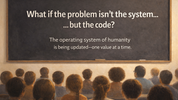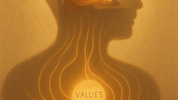A follow-on from last week's “Imagination as Our Superpower” — the final post in the ‘Meaning of Life’ mini-series
A quiet reflection on how our dreams, and the thoughts that shape them, may be influencing more than we realise.
Imagination Doesn’t Sleep
Last week, we explored imagination as one of the most underappreciated tools for healing, growth, and creation. But what if imagination doesn’t end when we fall asleep?
What if our dreams, even the ones we forget, continue shaping how we feel, think, and act when we wake?
And what if, by learning to influence them, we could gently influence the state we rise into each morning?
The State We Wake Into
We’ve all experienced it: waking with a feeling we can’t quite explain.
Anxiety. Warmth. Sadness. Clarity. Often, there’s no memory of a dream, just a lingering emotional residue.
That’s because even if we forget the dream, our nervous system remembers the emotional tone.
- If we dream of fear, we wake more guarded.
- If we dream of love, we wake more open.
And while we may not always choose what we dream, we can influence the emotional palette we draw from.
The Seeds of Dream: What We Think, We Weave
What we carry into sleep doesn’t vanish; it transforms.
Have you ever fallen asleep replaying a stressful event, only to wake up agitated or unrested? Or drifted off after watching something disturbing, then had a night of fragmented sleep?
The thoughts we dwell on, the stories we tell ourselves, the content we consume, all become the threads from which our subconscious weaves its nightly tapestry.
They become our inner curriculum.
Lucid Dreaming: A Gateway to Conscious Growth
Lucid dreaming is the art of becoming aware that you are dreaming… while still within the dream.
This isn’t fantasy or fiction. It’s an ancient practice found across cultures and now validated by neuroscience. This is where the mystical becomes measurable.
When we lucid dream, we’re no longer passive observers. We become participants. Creators. Explorers.
We can reflect. Rehearse. Rewrite.
Even begin to heal.
Instead of waiting for change in the waking world — which can be slow, painful, or constrained — we enter a parallel classroom. One where insights can unfold gently. Safely.
A Personal Reflection
With practice, I began to experience lucid dreams. I’d be dreaming, but aware I was dreaming. Sometimes, I can steer the dream or turn back time in scenarios to try out other strategies or approaches. I even develop and refine some of my coaching exercises during lucid dreams.
One night, during a lucid dream, I was shown how to connect with an ultra-intelligence. Having asked them to repeat the exercise several times to ensure I had the instructions exactly right, I forced myself awake so that I wouldn't forget the instructions. It was 5 a.m., which is not usual for me, and I sat upright and repeated the exercise. To my utter amazement, it worked.
In an instant, I was connected to what felt like a vast, patient super-intelligence. It was calm, powerful, and deeply present, as though it held the answer to everything I could possibly ask.
In that moment, the sheer scale of what I’d accessed overwhelmed me. I began to wonder, slightly anxiously, have I just connected to God? I asked, “Are you God?” The answer came back gently, “No”. Phew, I thought, that was close. I felt a wave of relief. Then, I began to think, if you are not God, who on earth are you? After what felt like ages of questioning and sensing, and a sense of patient amusement from their side, I finally asked, “Are you my Higher Self?” The answer was “Yes.”
That experience left an imprint I’ll never forget. What began as a simple exploration of a scientific coaching modality led me to a deeply personal and unexpected understanding of consciousness. One I am still exploring today.
A New Kind of Self-Leadership
We often speak of mindset and self-awareness.
But what if self-leadership also meant dream-awareness?
Not just being conscious during the day, but becoming conscious at night?
What if we could train our minds to recognise when we are dreaming, and interact with those dreams?
- To gently replay scenarios.
- To try out choices.
- To rehearse healing.
- To learn in safety and imagination — before taking action in waking life.
Because if what we dream shapes how we wake… And if what we think and feel shapes what we dream… Then perhaps the most powerful shift begins not in doing more, but in dreaming with better intentions.
A Quiet Invitation
- What would you most like to experience, or explore, if you knew you were dreaming?
- What’s the most vivid dream you’ve had recently? What made it stand out?
- And… how might your day be different if you could carry that feeling with you?
To begin experimenting with lucid dreaming, many teachers suggest three gentle practices:
- A pre-sleep affirmation, such as “Tonight, I remember my dreams. I have excellent dream recall.”
- A clear intention for insight, healing, or guidance
- A goal-oriented prompt, like asking to rehearse a scenario or explore a deeper truth
Just a few mindful minutes before sleep can change the entire emotional flavour of our rest — and our waking state.
Why It Matters
Lucid dreaming was once seen as mystical. Now it’s confirmed by neuroscience.
Brain scans have shown that lucid dreamers activate parts of the prefrontal cortex associated with self-awareness, while asleep.
It’s another reminder that science continues to affirm what ancient traditions long understood: We are capable of far more than we consciously realise.
Not just during the day. But all through the night.
What might become possible if we started inviting, instructing and remembering our dreams?
Further Reading & Exploration
If this idea of conscious dreaming resonates with you, I highly recommend exploring the work of Charlie Morley, who teaches lucid dreaming as a tool for healing, shadow integration, and inner transformation. His TEDx talk and book are excellent starting points.
And if you are interested in the neuroscience of lucid dreaming, here are several sources:
- The Cognitive Neuroscience of Lucid Dreaming (2021) - video report - looking at a pharmaceutical approach
- The neuroscience of lucid dreaming (2024)
- Neuropsychopharmacological Induction of (Lucid) Dreams: A Narrative Review (2024) supports the use of certain herbs like Calea zacatechichi, mugwort, and Silene capensis.
 unknownx500
unknownx500





